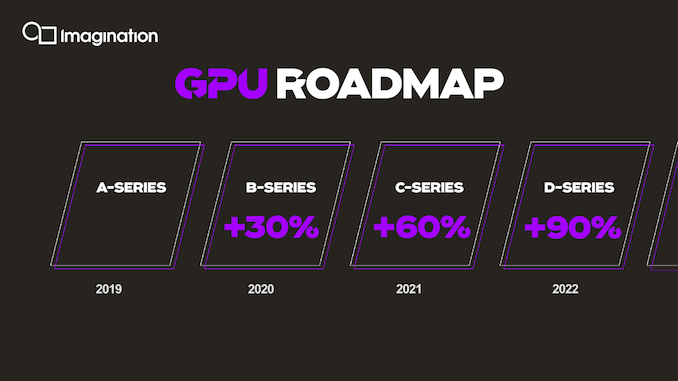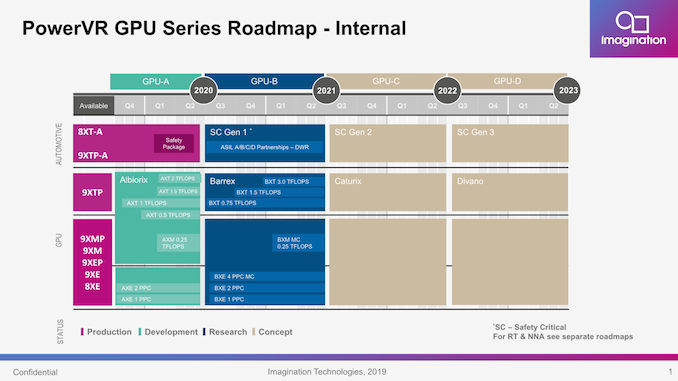Imagination Announces A-Series GPU Architecture: "Most Important Launch in 15 Years"
by Andrei Frumusanu on December 2, 2019 8:00 PM ESTFuture Roadmap & Final Thoughts
The new A-Series architecture means to represent a reset for Imagination’s product offerings, representing a bright new future for the company. The new GPU IP is certainly impressive in terms of the PPA metrics that it promises to achieve, and if realized, it does have ramifications for the wider industry and the competitive landscape.
But even if the A-series can deliver on all of Imagination's promises, the company can't stop there. The competition is continuing to refine and improve their designs, and so must Imagination. To that end, along with today's announcement of the A-series, Imagination is also publishing a very broad roadmap for the next few years, outlining the upcoming GPU generations and their expected performance gains. All of this is especially important for SoC designers, who want to know what's coming down the pipe before making the effort to switch IP vendors.
Imagination’s roadmap following the A-Series is seemingly very aggressive, promising yearly updates going forward, with large annual performance increases of 1.3x, or a 30% yearly compound annual growth rate. This is a much bigger goal than we’re used to historically, but it’s very much in line with the pace of progress we’ve seen from some vendors in the past, or even what Apple has managed to recently achieve over the last two generations.
For the A-Series, Imagination has adopted a public announcement schedule more similar to Arm’s, meaning that the A-Series has already been finished and licensed out to customers, with SoCs being designed and prepared to hit the market for 2020 – we’re assuming the latter part of 2020.
The B-Series is already well under way in terms of development and projected to be completed by next summer if the roadmap is to be taken as an accurate schedule, so at least Imagination has a strong path forward.
What’s important here for Imagination, is managing to actually achieve design wins for the new GPU IP in meaningful higher volume sockets. In terms of possible customers, it’s an increasingly small list, with most of them being the smaller Chinese SoC vendors such as RockChip, Unisoc (formerly Spreadtrum). Samsung is an unlikely client given their plans with AMD as well as custom GPU development, unless there happens to be some opportunity in the low and mid-range segments. HiSilicon likely is tied to Arm, if their plans of a custom GPU don’t pan out. This leaves MediaTek as one of the bigger clients, with the most opportunity and likelihood of adopting the A-Series. Holding onto more MediaTek SoC wins, instead of having them flip-flop between PowerVR and Mali, would be a big win for Imagination and its GPU group. With MediaTek now having re-entered the flagship SoC market, it seems like a very good match.
The wider semiconductor industry is said to be in an architecture revival phase, realizing the need for stronger designs in order to make up for decreasing yearly improvements in process performance. Imagination’s A-Series here seems to be a perfect example of such a revitalization, bringing with it massively impressive generational jumps. If the improvements pan out in practice, I do believe it could be a turning point for the company, and in the future we indeed might look back on it as being the most important launch in the company’s mobile history.












143 Comments
View All Comments
RaduR - Tuesday, December 3, 2019 - link
Andrei Frumusanu was working for them . So maybe he has more info on how this is going to develop .The only downside for ImgTec is that they are depending on CPU vendors. So if they cannot sell this design to anyone ....
They tried with MIPS but for whatever reason MIPS lost traction . Most probably they wer eunable to sell the design .
Please understand that ImgTec is a very very small company that is fighting in fact with ARM . They are not Mediatek nor Qualcomm . In this market there is a lot of completion.
We have : Vivante in the lowend. Broad iMM has Videocore , ARM sells MALI together with Cortex designs. So how can ImgTec survive ?
I see the only option would have been MIPS + PowerVR or to be taken over by a company like Mediatek . I am still wondering why Intel did not buy them for the cheap or Mediatek .
Andrei Frumusanu - Tuesday, December 3, 2019 - link
I left back in November 2017 and avoided coverage till now due to any conflict of interest. The A-Series is beyond the horizon of future knowledge I had from back then so it was new to me, I don't have any more info beyond my estimates that I wrote.Vivante is effectively dead and so is the Videocore lineup, the best case scenario here is a 50/50 split with Arm. The CPU I thing I don't think it's a limitation as long as the GPU in fact does deliver on competitive PPA.
ZolaIII - Tuesday, December 3, 2019 - link
I wouldn't exactly say Unisoc adoption of it would have a small impact (tho they are still recovering from bad Intel's influence) nor would I write of possibility of HiSilicone adoption (more so as they are keen on ARM for US ban compliance & after all Chinese IPO owns Imagination now). Actually this is going so far right now that RISC V foundation is moving out of US to neutral grounds to ensure that same fate that struck the ARM cannot happen to them.vladx - Wednesday, December 4, 2019 - link
ARM is also planning to move remaining R&D centers from US to avoid any chance of US ban in the future.vladx - Wednesday, December 4, 2019 - link
Did anyone use Vivante designs in their SoCs in the past 3 years or so?GruenSein - Tuesday, December 3, 2019 - link
Uncertainties about ImgTech's claims and promises aside, I am wondering who is supposed to be the customer.Apple is developing their own GPUs now.
Samsung is going with AMD's RDNA.
Qualcomm has their Adreno GPU.
HiSilicon is using ARM's Mali.
I fear that this will be a very niche product unless it absolutely dominates all other solutions.
Raqia - Tuesday, December 3, 2019 - link
If they remain independent, I think it'll be anyone who wants something better than Mali or Intel that don't have their own GPU or haven't partnered up, so with Intel also designing their own GPU cores I guess the main customer would be Mediatek, and a handful of other even smaller licensees like Broadcom for things like its Raspberry Pi SoC, NXP, STM etc.When compared to CPU designs which are becoming increasingly commoditized by ARM's freely licensed and very good SIP cores (with only nVidia and Apple doing their own custom cores in volume going forward), efficient GPU cores continue to be highly specialized and a well sought after technology. Imagination would also be a layup acquisition for any company besides Apple, AMD, or Qualcomm, so I could Intel, Samsung or ARM buying them in the future.
Raqia - Tuesday, December 3, 2019 - link
Also Marvell and other TV / automakers.name99 - Tuesday, December 3, 2019 - link
Amazon made a big deal about GPU support and AI inference in their Graviton 2 announcement. They might be an unexpected client?(For that to work, however, IMG might have to be more flexible in terms of being willing to scale up/drop functionality to match AMZ's needs. They were apparently unwilling to be that flexible for Apple... But hey, near death experience can sometimes teach...)
mode_13h - Wednesday, December 4, 2019 - link
I'm sure Amazon is just talking about Nvidia and possibly AMD. Nvidia is officially supporting their software stack on ARM, and AMD's is opensource and could be recompiled for ARM (hey, it works on POWER!).